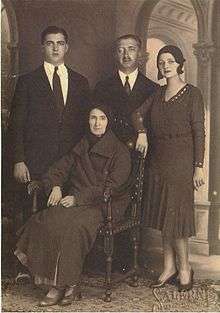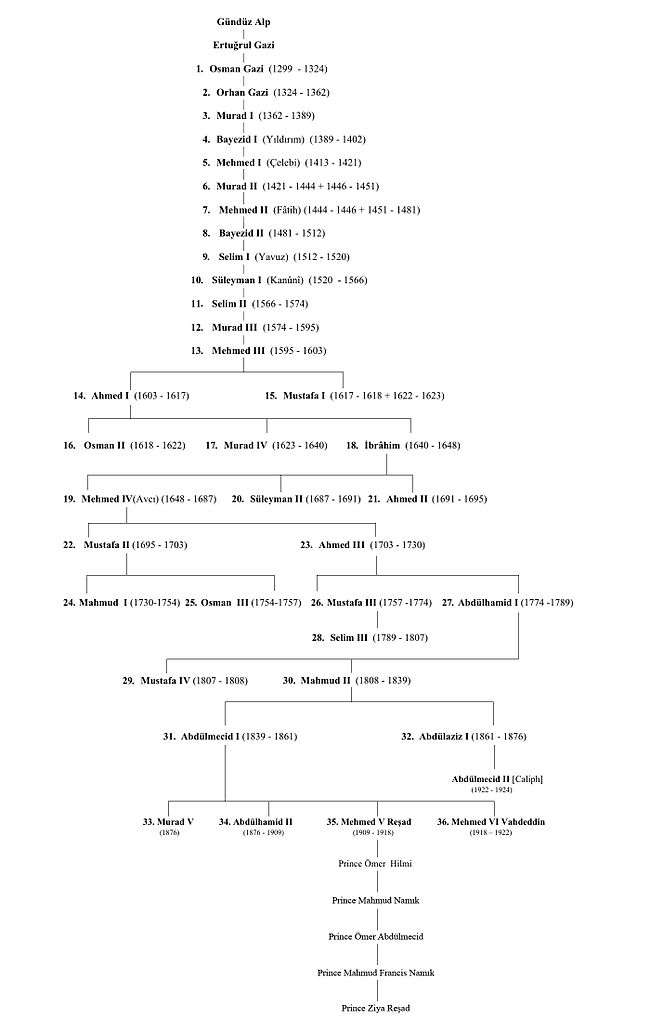Şehzade Ömer Hilmi
| Şehzade Ömer Hilmi | |
|---|---|
| Colonel of Inf. Ottoman Army | |
| Born |
2 March 1886 Veliahd Palace, the Crown Prince’s Palace, İstanbul, Ottoman Empire |
| Died |
6 April 1935 (aged 49) Alexandria, Egypt |
| Spouse |
Nesimter Hanım Gülnev Hanım Faika Hanım Bahtıter Hanım Mediha Hanım |
| Issue |
Prince Mahmud Namık Princess Emine Mükbile |
| House | Imperial House of Osman |
| Father | Sultan Mehmed V Reşad |
| Mother | Mihrengiz Kadın |
| Religion | Islam |
Şehzade Ömer Hilmi, Colonel of Infantry of the Ottoman Army Omer Hilmi,[1] Prince (Şehzade) Ömer Hilmi Efendi[2] was born at the Veliahd Palace (the Crown Prince’s Palace), Ortaköy, Istanbul on 2 March 1886, as the third son of Mehmed V, by his third wife Empress Mihrengiz Kadın.[3] He was educated privately. He received the Collar of the Hanedan-i-Ali-Osman and the Nişan-ı-Ali-Imtiyaz, GC of the Order of Leopold of Austria (1917).
| Imperial Ottoman Dynasty | |
|---|---|
 | |
| Country | Ottoman Empire |
| Founded | 1299 |
| Founder | Osman I |
| Dissolution | 1922 |

Early years
Ömer Hilmi Efendi lived most of his life in İstanbul in the restrictive surroundings of Dolmabahçe Palace. He was born in the apartments reserved for the Veliahd, the Crown Prince, and then moved into the main palace once his father had become the Ottoman Sultan on 27 April 1909. Together with his brother, he tried to support his father during the difficult years of the First World War. On the death of his father on 4 July 1918, just before the end of the war, he and his family left Dolmabahçe Palace and moved to a Konak at Nişantaşı during the winter months and to one in Bağlarbaşı, above Beylerbeyi, for the summer.
Exile
Following the establishment of the Turkish Republic and the aboliton of the Ottoman Sultanate and the Ottoman Caliphate, the entire Imperial Ottoman family were forced into exile in March 1924. Aged 38, Ömer Hilmi Efendi, left Turkey never to return, since he died before the decree of exile was lifted. He went into exile with his mother, Mihrengiz Kadınefendi, who had been the wife of Sultan Mehmed V, and with his two young children, Mahmud Namık Efendi and Princess Emine Mükbile Sultan. Like all other members of the Imperial family, they left İstanbul from Sirkeci Train Station and first went to Budapest. They lived here for a few months, then moved to Vienna, then Paris, before settling in Nice, France. As the former Ottoman Sultan, Sultan Mehmed VI, had settled in San Remo, many members of the family had congregated in the South of France. After living in Switzerland for a short time, his cousin, the last Caliph of Islam Prince Abdulmecid, also moved to Nice. Ömer Hilmi Efendi spent the next 11 years of his life in Nice, struggling to adapt to life in exile, before moving to Alexandria, Egypt in January 1935 with his family. Life in exile was always very difficult since members of the Imperial Ottoman family had no financial means, and all yearned to return to their homeland.
Illness and Death
His daughter, Princess Emine Mükbile Sultan, who had married her distant cousin Prince Ali Vasib Efendi in 1931, cared for him, her grandmother and brother during all this time. Ömer Hilmi Efendi suffered from a stroke and died soon after settling in Alexandria. He died age 49 at Alexandria, on 6 April 1935, and was buried in Khedive Tawfik Mausoleum, Cairo, Egypt.
Personal life
- HIH Princess Nesimter Hanım, married at Istanbul, Yıldız Palace, and divorced at Istanbul, Dolmabahçe Palace, in January 1915, without issue.[4]
- HIH Princess Gülnev Hanım (Gence, Aegean, 21 February 1890 - died aged 29 Nişantaşı, 31 December 1919, from Spanish influenza, following an epidemic of the disease, buried in Sultan Reşad Mausoleum, Eyüb), married at Istanbul, Yıldız Palace on 3 October 1910, alias Firdevs, née Hatice, daughter of Fırat Bey by his wife Ayşe Hanım, recognized by her father-in-law, Sultan Mehmed V, for her dedication to charitable causes and was awarded The Imperial Order of Appreciation – First Class. She had issue, one son and one daughter:
- HIH Prince Şehzade Mahmud Namık (Dolmabahçe Palace, 23 December 1913 - Cairo, Egypt, 13 November 1963, buried in Khedive Tawfik Mausoleum, Cairo, transferred to Sultan Mahmud II Mausoleum Istanbul in 1987), Received the Collar of the Hanedan-ı-Ali-Osman, Businessman, married in August 1939 (div. at Alexandria, 1947) Şaharazade Hanım (Alexandria, 1922 - 1993), only daughter of Ismail Ratib Bey, by his wife Princess Emine Bihruz Hanım, younger daughter of Prince Ibrahim Raşid Fazıl Paşa, of Egypt. He had issue, an only son:
- HIH Prince Şehzade Ömer Abdülmecid Osmanoğlu (Alexandria, 4 June 1941), educated at the Stowe school, Buckinghamshire, England, and a degree in business administration from London University, married Beulah Hanım (8 April 1943), née Banbury. He has issue, an only son:
- HIH Prince Şehzade Mahmud Namık Osmanoğlu (London, 27 April 1975) educated MFA in Design and Technology from Parsons The New School for Design, New York City, USA. He is a co-founder and director of an online health channel, he lives in England, married Inci Hanım, née Genevieve Robson: He has issue, two sons
- HIH Prince Şehzade Ziyaeddin Reşad (London, 6 June 2012)
- HIH Prince Şehzade Cem Ömer (London, 5 August 2015)
- HIH Prince Şehzade Mahmud Namık Osmanoğlu (London, 27 April 1975) educated MFA in Design and Technology from Parsons The New School for Design, New York City, USA. He is a co-founder and director of an online health channel, he lives in England, married Inci Hanım, née Genevieve Robson: He has issue, two sons
- HIH Prince Şehzade Ömer Abdülmecid Osmanoğlu (Alexandria, 4 June 1941), educated at the Stowe school, Buckinghamshire, England, and a degree in business administration from London University, married Beulah Hanım (8 April 1943), née Banbury. He has issue, an only son:
- HIH Princess Emine Mükbile Sultan (Dolmabahçe Palace, 17 September 1911 - Istanbul, 21 May 1995, buried in Sultan Reşad Mausoleum, Eyüb), Received the Collar of the Hanedan-ı-Ali-Osman and the Nişan-ı-Şefkat 1st class, married at Nice, France, on 24 April 1931, Prince Şehzade Ali Vasib, 41st Head of the Imperial House of Osman (Çırağan Palace, 13 October 1903 - Alexandria, 9 December 1983), only son of Prince Şehzade Ahmed Nihad, 38th Head of the Imperial House of Osman, by his first wife, Safru Hanım. She had issue, an only son:
- HIH Prince Şehzade Osman Selaheddin Osmanoğlu (Alexandria, Egypt 7 July 1940), educated at the Victoria College, Alexandria, then London to become a member of the Institute of Chartered Accountants, married in London, on 27 August 1966 (div.), Athena Joy Hanım (born London, 9 March 1944), née, Christoforides. He has issue, three sons and one daughter:
- HIH Prince Şehzade Orhan Murad Osmanoğlu (Henley-on-Thames, England, 26 December 1972, educated Degree in Busıness Studies at Kingston University, London, has had a career in the IT industry and now works for a Property Holding Company, married on 17 February 2000, Emine Hanım née, Patricia Iotti. He has issue, two sons:
- HIH Prince Şehzade Turan Cem (born High Wycombe, England, 7 January 2004)
- HIH Prince Şehzade Tamer Nihad (born High Wycombe, England, 15 April 2006)
- HIH Prince Şehzade Nihad Rashid (Marlowe, 17 September 1978 - Woking, Surrey, 19 December 1978)
- HIH Prince Şehzade Selim Süleyman Osmanoğlu (High Wycombe, England, 15 December 1979) educ. Degree in Business Studies at Kingston Univ., London and Fellow of the Chartered Institute of Insurance, a Chartered Insurance Broker and a Member of the Institute of Risk Management, married at İstanbul, on 22 June 2003, to Alev Hanım, née, Öcal. educated at the Boğaziçi University, İstanbul. He has issue, one son and one daughter:
- HIH Prince Şehzade Batu Bayezid Efendi (born Sidcup, England, 23 April 2008)
- HIH Princess Esma Emira Sultan (born 19 June 2015)
- HIH Princess Ayşe Gülnev Osmanoğlu Sultan (born Henley-on-Thames, England, 17 January 1971), educucated in History and Politics at Exeter University and a master's degree in Ottoman history at S.O.A.S. London, married on 27 August 1994, to Damad Nicholas Nelson Sutton (born 18 August 1969), educated at the Exeter University and Chartered Accountant, Dir. Property Holding Company. She has issue, four sons and one daughter:
- Prince (Sultanzade) Maximilian Ali Beyefendi, Sutton (London, 15 January 2000)
- Prince (Sultanzade) Cosmo Tarik Beyefendi, Sutton (London, 10 September 2001)
- Prince (Sultanzade) Lysander Cengiz Beyefendi, Sutton (London, 12 April 2003)
- Prince (Sultanzade) Ferdinand Ziya Beyefendi, Sutton (Sussex, England, 26 July 2006)
- Princess Tatyana Aliye Hanımsultan, Sutton (Sussex, England, 25 March 2005)
- HIH Prince Şehzade Orhan Murad Osmanoğlu (Henley-on-Thames, England, 26 December 1972, educated Degree in Busıness Studies at Kingston University, London, has had a career in the IT industry and now works for a Property Holding Company, married on 17 February 2000, Emine Hanım née, Patricia Iotti. He has issue, two sons:
- HIH Prince Şehzade Osman Selaheddin Osmanoğlu (Alexandria, Egypt 7 July 1940), educated at the Victoria College, Alexandria, then London to become a member of the Institute of Chartered Accountants, married in London, on 27 August 1966 (div.), Athena Joy Hanım (born London, 9 March 1944), née, Christoforides. He has issue, three sons and one daughter:
- HIH Prince Şehzade Mahmud Namık (Dolmabahçe Palace, 23 December 1913 - Cairo, Egypt, 13 November 1963, buried in Khedive Tawfik Mausoleum, Cairo, transferred to Sultan Mahmud II Mausoleum Istanbul in 1987), Received the Collar of the Hanedan-ı-Ali-Osman, Businessman, married in August 1939 (div. at Alexandria, 1947) Şaharazade Hanım (Alexandria, 1922 - 1993), only daughter of Ismail Ratib Bey, by his wife Princess Emine Bihruz Hanım, younger daughter of Prince Ibrahim Raşid Fazıl Paşa, of Egypt. He had issue, an only son:
- Çamlıca Palace, and divorced to HIH Princess Faika Hanım, married at Istanbul, Üsküdar, Çamlıca Palace, without issue. In 1934 she took the surname 'Hunca'.
- HIH Princess Bahtıter Hanım (Izmir, 12 October 1897 - 1984), married at Istanbul, Üsküdar, Çamlıca Palace, 16 June 1914, without issue.
- HIH Princess Mediha Hanım (Alexandria, 4 November 1903 - Cairo, Egypt, 1971), married at Istanbul, Nişantaşı Palace, on 12 July 1921, without issue.
Family Tree
Showing the line of descent from the founder of the Ottoman dynasty to present day through Sultan Mehmed V Reşad's youngest son Prince Ömer Hilmi Efendi

References
- ↑ Hugh Montgomery-Massingberd, Burke's Royal Families of the World, Africa & the Middle East, Burke's Peerage, 1980, p. 247.
- ↑ Almanach de Gotha (184th ed.). Almanach de Gotha. 2000. pp. 365, 912–915.
- ↑ Ali Vâsıb, Bir Şehzadenin Hâtırâtı: Vatan ve Menfâda Gördüklerim ve İşittiklerim, Yapı Kredi Kültür Yayınları, 2004, ISBN 978-975-08-0878-4, p. 205
- ↑
Bibliography
- Osmanoğlu, Osman Selaheddin (2003). Bir Şehzadenin Hâtırâtı. Turkey: Yapı Kredi Yayınları. ISBN 975-08-0878-9. OCLC 469568294. Retrieved 20 July 2011.
External links
- "Ottoman Family". Official website of the immediate living descendants of the Ottoman Dynasty. Retrieved 14 February 2010.
- "Genealogy of the Ottoman Family". Retrieved 19 August 2008.
- Family Tree, descendants of Sultan Mahmud II. Retrieved 2011-02-28.